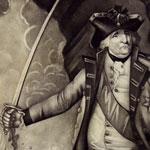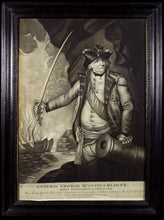Mezzotint - General George Augustus Eliott, Baron Heathfield of Gibraltar, 1789
- Regular price
- £725
- Sale price
- £725
- Regular price
-
- Unit price
- /per
Adding product to your cart
Overall: 41cm (16.1in) x 31cm (12.2in)
Mezzotint. Threequarters length looking to right, wearing a tricorne with Hanoverian cockade, General officer’s coatee with sash and breast star of the Order of the Bath, holding a sword in his right hand, his left resting on the barrel of a cannon, an enemy vessel on fire in the background. Inscribed below the image with the title ‘General George Augustus Eliott. / Baron Heathfield of Gibraltar. / Who so bravely defended that Noble Fortress against the united force of Spain & France on the the 14th of Sept. 1782. / Published 14th Sept. 1789 by Robt. Sayer, 53 Fleet Street, London.’ Contained in a period ebonised and glazed frame.
General Eliott crowned a tough career with a three year long defence of Gibraltar with a heavily out numbered garrison of less than 7,000 men and 100 guns. When the Spanish seige began in 1777, his force seemed barely sufficient; its efficiency and morale were, however, sustained by Eliott’s rugged and distinctive personality. In January 1780 Admiral Rodney brought supplies and mauled the Spanish fleet; in April Admiral Darby brought in a fresh convoy. From that point, however, the seige became more intense. After their capture of Minorca in February 1782, the French joined in, sensing the that British, with their recent reverses in America, were doomed. In May, they sent in ten floating batteries, screened by dampened sandbags but these were pulverised by Eliott’s red-hot shot. On 13 September, having failed starve Eliott out, the French and Spanish launched a grand attack, involving 100,000 men, forty-eight warships and 450 cannon. They came near to success but by nightfall on the 14th the British had destroyed every floating battery. Elliot’s skill in directing the defence are upheld as a tour de force of military engineering and gunnery. No less vital was his leadership in the battle against morale. He dominated by personal example but understood the needs of lesser men. He was a vegetarian, a teetotaller and a cat lover. When a soldier was charged with intent to desert to the enemy, Eliott declined to have him shot and declared him insane. The soldier was accordingly bled, put a strait-jacket, and prayed for in church.
Read More
George Augustus Eliott, 1st Baron Heathfield, K.B., P.C., (1717-1790) was the son of Scottish baronet and was educated at the University of Leiden and the école militaire at La Fère. He served in the Prussian Army before transferring to the British service and joining both the Engineers and 2nd Troop of Horse Grenadier Guards, of which he was afterwards Lieutenant-Colonel. He served throughout the War of Austrian Succession between 1742 and 1748, being wounded at Dettingen and Fontenoy. He was aide-de-camp to King George II between 1756 and 1759 and commanded a light cavalry brigade at the Battle of Minden in 1759. Prize money from the Capture of Havana where he was second-in-command enabled him to buy Heathfield Park in East Sussex which he altered and enlarged over the years. In May 1777 he was appointed Governor of Gibraltar. Following the successful defence, Eliott returned to England, was raised to the peerage and installed as Knight of the Bath. He died at the Schloss Kalkofen, Aachen while making his way back to Gibraltar overland.








